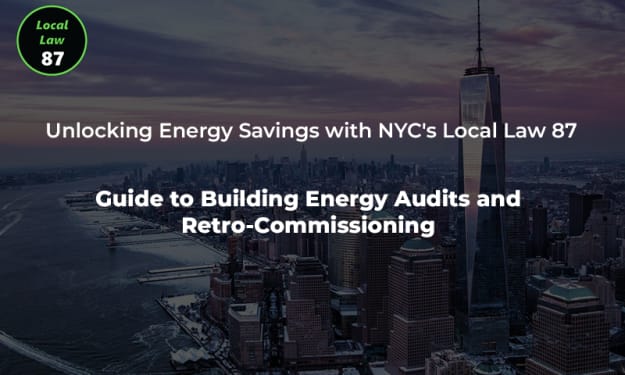Key Compliance Requirements of Local Law 97: What Building Owners Should Know
Local Law 97

Local Law 97, also known as LL97 NYC or Local Law 97 New York, is a groundbreaking regulation enacted by the city of New York to address the urgent need to reduce greenhouse gas emissions from buildings. As the largest source of emissions in the city, buildings are a critical focus area in the fight against climate change. This article will outline the key compliance requirements of Local Law 97 and provide building owners with essential information they need to know.
Understanding Local Law 97
Local Law 97 is a part of New York City's comprehensive Climate Mobilization Act, which aims to achieve significant emissions reductions by 2050. LL97 NYC sets carbon emission limits for buildings over a certain size. It applies to buildings over 25,000 square feet and covers a wide range of property types, including residential, commercial, and mixed-use buildings.
The purpose of Local Law 97 is to ensure that buildings contribute to the city's sustainability goals by reducing their carbon footprint. By establishing emission limits, the law drives building owners to implement energy-efficient measures and invest in renewable energy sources, ultimately contributing to a greener and more sustainable New York City.
Carbon Emission Limits
One of the primary compliance requirements of Local Law 97 is the establishment of carbon emission limits for covered buildings. These limits are based on a building's occupancy classification and are measured in kilograms of carbon dioxide equivalent per square foot (kgCO2e/ft2) annually. The emission limits will be tightened over time, with more stringent requirements coming into effect in 2024, 2030, and beyond.
Building owners must monitor and track their building's emissions to ensure compliance with the established limits. This involves gathering data on energy consumption, calculating emissions, and implementing strategies to reduce carbon output.
Compliance Deadlines
Building owners need to be aware of the compliance deadlines set by Local Law 97. The law establishes three compliance periods: 2024-2029, 2030-2034, and 2035-2039. During each compliance period, buildings must meet the corresponding carbon emission limits. Non-compliance with the emission limits can result in substantial penalties for building owners.
To comply with the law, building owners should start planning and implementing energy efficiency measures as early as possible to meet the upcoming compliance deadlines. Taking a proactive approach will not only ensure compliance but also allow for sufficient time to explore cost-effective solutions and access available incentives and grants.
Penalties for Non-Compliance
Building owners who fail to meet the carbon emission limits outlined in Local Law 97 may face significant penalties. The penalties are calculated based on the excess emissions, which are measured as the difference between a building's actual emissions and the applicable emission limit. The penalty rate for excess emissions will increase over time, emphasizing the urgency and importance of compliance.
Penalties for non-compliance can have a substantial financial impact on building owners. It is crucial to prioritize energy efficiency measures and make the necessary investments to avoid penalties and ensure compliance with Local Law 97.
Building Energy Efficiency Grades
To encourage transparency and inform the public about a building's energy efficiency, Local Law 97 introduces the concept of Building Energy Efficiency Grades. These grades range from A to F and will be displayed in a prominent location within the building. The grades will be based on the building's energy efficiency performance relative to the emission limits set by the law.
The Building Energy Efficiency Grades allow the public to assess a building's environmental impact and energy efficiency efforts. Building owners should strive to achieve high grades to showcase their commitment to sustainability and attract environmentally conscious tenants or occupants.
Building owners should focus on implementing energy-efficient measures, such as upgrading HVAC systems, improving insulation, and optimizing lighting systems, to improve their building's energy performance. These actions can help reduce carbon emissions and increase the likelihood of obtaining a favorable energy efficiency grade.
Required Retrofits and Upgrades
Local Law 97 mandates that building owners implement energy efficiency measures to meet the emission limits. These measures can include retrofits, upgrades, and improvements to a building's energy systems, such as heating, cooling, ventilation, lighting, and insulation. Building owners should conduct energy audits and work with qualified professionals to identify and implement cost-effective energy-saving measures.
Retrofitting buildings with energy-efficient technologies and upgrading outdated systems can significantly reduce energy consumption and emissions. Some common retrofit options include installing high-efficiency HVAC equipment, upgrading to LED lighting, and enhancing insulation to minimize heat loss. Building owners should explore available financial incentives, grants, and financing options to support the cost of these improvements.
Renewable Energy Offsets
In cases where a building cannot achieve the required emission reductions through on-site measures alone, Local Law 97 allows for the use of renewable energy offsets. These offsets involve purchasing renewable energy certificates (RECs) or contributing to an equivalent emission reduction project elsewhere. However, the law places limits on the percentage of emissions that can be offset through this mechanism.
Building owners should assess their building's potential for renewable energy generation, such as solar panels or wind turbines, to offset a portion of their carbon emissions. Additionally, exploring community solar programs or entering into power purchase agreements (PPAs) can help increase the availability of renewable energy and reduce reliance on fossil fuels.
Reporting and Compliance Documentation
Building owners required to submit annual emissions reports to the city's Department of Buildings (DOB) as part of the compliance process. These reports must prepared by a qualified professional and include detailed information on the building's energy consumption, emissions, and any implemented energy efficiency measures. Compliance documentation must also maintained and made available for inspection upon request.
Accurate and timely reporting is crucial to demonstrate compliance with Local Law 97. Building owners should ensure that they keep comprehensive records of energy usage, retrofits, upgrades, and any renewable energy offsets. Engaging with energy consultants or professionals experienced in LL97 compliance can help streamline the reporting process and ensure accurate documentation.
Conclusion
Local Law 97, or LL97 NYC, is a significant regulation that demands building owners to take proactive steps in reducing carbon emissions and improving energy efficiency. Understanding the key compliance requirements of Local Law 97 is essential for building owners to avoid penalties, achieve energy efficiency grades, and contribute to New York City's sustainability goals.
By embracing energy-efficient retrofits, upgrades, and renewable energy solutions, building owners can not only comply with Local Law 97 but also reduce operating costs, increase property value, and enhance the overall sustainability of their buildings.
To successfully navigate Local Law 97, building owners should seek expert guidance, explore available incentives and financing options, and prioritize the implementation of energy-efficient measures. By doing so, building owners can play a significant role in creating a greener and more sustainable future for New York City.
About the Creator
The Cotocon Group
Sustainability Consulting Experts in NYC. Leading the Real Estate Industry in Reducing GHG Emissions & Increasing Property Value.
Website :- https://www.thecotocongroup.com






Comments
There are no comments for this story
Be the first to respond and start the conversation.